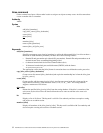
3
2 Intel
®
Blade Server Fibre Channel Switch
Module SBCEFCSW
✏ NOTE
Throughout this publication, the phrases "switch module" and "fibre channel switch module" refer
to the Intel
®
Blade Server Fibre Channel Switch Module SBCEFCSW.
You can manage and configure your Intel
®
Blade Server Fibre Channel Switch Module SBCEFCSW through a
Telnet connection to the embedded command line interface (CLI) or by using the SAN Utility application. The
SAN Utility provides an intuitive graphical user interface (GUI) that you can use to configure multiple fibre
channel switch modules through other connected SAN devices from a single interface. The SAN Utility
application is referred to throughout this publication as the SAN Utility.
This guide provides instructions to:
• Configure your switch module
• Manage fabrics, ports, and switch modules
• Use Telnet and the CLI to configure switch module parameters
You can manage the SBCE fabric through an Ethernet network using the SAN Utility or the CLI. The SAN
Utility is installed on a Microsoft* Windows* 2003, Red Hat* Linux* Advanced Server Version 2.1 or Red
Hat Linux Version 9.0.
The switch module has an embedded Telnet server through which a Telnet client can connect and manage the
switch module using the CLI. See “Command line interface (CLI)” below for more information about Telnet
and CLI commands.
SNMP provides monitoring and trap functions for the fabric. The switch module firmware supports SNMP
Versions 1, 2, and 3; the Fibre Alliance Management Information Base (FA-MIB) version 4.0; and the Fabric
Element Management Information Base (FE-MIB) RFC 2837. Traps are formatted using SNMP version 2.
If you are an experienced user, you can use the Telnet CLI to perform the following tasks:
• Manage the switch module from the SBCE management module interface to the Telnet client
• Perform single switch management
• Use advanced control commands
If you are a new user or if you need to manage multiple switch modules from a single interface, you can use
the SAN Utility GUI to perform the following tasks:
• Manage your switch module from a remote client or network management workstation
• Manage your multiswitch fabric
For information about installing the switch module and the SAN Utility, see the Switch Module Installation
Guide that comes with the switch module.


















